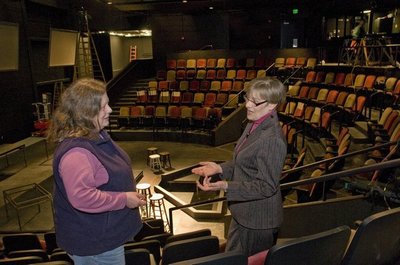October 1, 2009
Opening the curtain on a new life for an old theater
A community open house will be held to celebrate the grand re-opening of the renovated School of Drama’s Playhouse Theatre, now called the Floyd and Delores Jones Playhouse Theater. The open house will be from l to 6 p.m. Friday, Oct. 2, and will include tours for members of the public to visit all backstage spaces.
The official grand re-opening is Oct. 30. The first production of the season will be Shakespeare’s The Tempest, directed by M. Burke Walker, UW alumnus and founder of The Empty Space Theatre. The cast will comprise members of the Professional Actor Training Program and School of Drama undergraduate actors.
The theater has undergone a $10 million renovation, funded in part by a nearly $2.4 million donation by the Floyd & Delores Jones Foundation. See our story about the renovation here.
Floyd Jones funded the first endowed chair in the arts at the University — a position that rotates among the University’s arts units — and was hesitant to make another major gift. But as he learned more about the history of the building, he changed his mind. The theater company, The Seattle Repertory Playhouse (not affiliated with the current Seattle Repertory Theatre), a private nonprofit company, housed one of the few “Negro Theatre Units” beginning in 1936 under the Works Progress Administration/Federal Theatre Project, and their productions regularly attacked racial stereotypes. In 1948, the company was investigated by Washington State’s Canwell Committee — an Un-American Activities Committee during the Red Scare which ultimately doomed the company. The University bought the building in 1950. (See a story from Columns magazine about the theater’s history here.)
It was after learning these facts that Jones realized the theater would be a fitting tribute to his wife, Delores, a lifelong theatergoer and champion for social justice, who died in 2005. “When I learned about the theater’s controversial history, it just made it more interesting,” he says. “It’s been quite dynamic, with several rises and falls.”
The renovation, designed by Seattle’s LMN Architects and built by Wick Constructors, includes several sustainable design strategies. The lobby features natural ventilation and a radiant heat floor. The auditorium includes a ventilation system that can also be used to exhaust theatrical smoke effects from the stage. Plumbing fixtures are low-flow and lighting was designed to achieve a balance between sustainability goals and theatrical functionality. The project has a certification of Leadership in Energy and Environmental Design Gold rating from the U.S. Green Building Council. It is the first LEED Gold rated theatre in the country. The project documented 45 percent energy and 30 percent water savings, 95.8 percent construction waste recycling, low VOC products in paints and adhesives, no urea formaldehyde in wood products and a green housekeeping program to maintain the building. An elm tree removed from the site during construction was reused to create benches, which are featured as seating in the lobby (See our story about the benches here.)
Audiences will particularly enjoy better sight lines from all seats, a spacious lobby, new seating and an indoor box office window.
A BRIEF HISTORY:
1930: Originally a tile warehouse, the building was remodeled into a theatre space by Florence and Burton James, and Albert Ottenheimer, co-founders of the Seattle Repertory Playhouse theatre company (not connected to the current Seattle Repertory Theatre). Renowned Seattle architect Arthur Loveless created an “English Rambler” style design for the proscenium theatre. Famed Seattle artist Mark Tobey contributed small mosaics which flank the doorway.
1936: Became part of the WPA’s (Works Progress Administration) Federal Theatre Project, and housed one of the few “Negro Units” in the country. The company was regarded by Project National Director Hallie Flanagan as the finest of the national troupes and the Seattle Company’s plays (some of which were written by black playwrights) were known for regularly attacking existing racial stereotypes and featured racially integrated productions (revolutionary at the time).
1930-1948: Seattle Repertory Playhouse produced 2,500 performances of 167 plays in its 18-year existence. The company employed a total of 876 actors and 124 technicians, 22 staff members and enjoyed a subscription base that ultimately exceeded 5,000 patrons. The Seattle Repertory Playhouse was considered a “civic” theatre described itself as a theatre who “keeps itself in direct contact with all the activities and needs of a people.” Plays by Scandinavian authors were presented every season, and new dramas by Northwest playwrights were regularly produced. The Seattle Repertory Playhouse was also known for its children’s puppet plays presented in coordination with Seattle’s Junior League, and it had the largest theatre education program in the United States, touring plays by Shakespeare to over 70,000 high school students throughout the state.
1948: The Jameses and Ottenheimer were investigated for un-American activities by the Canwell Committee, a pre-McCarthyite committee in Washington State. The investigation ultimately destroyed the Jameses and the Seattle Repertory Playhouse and three tenured professors were fired from the UW.
1950: The Playhouse was acquired by the University to address a need for an experimental laboratory theatre to train UW drama students.
1967: Greg Falls, then director of the School of Drama, headed a renovation project primarily to change the stage from a proscenium to a thrust stage.
1950-2009: The Playhouse continues to play a critical role in training top-notch theatre artists at the School of Drama. Founders and artistic directors of many of Seattle’s leading theatres were first students or faculty at the School, including Greg Falls (ACT Theatre), Duncan Ross (Seattle Repertory Theatre), Ruben Sierra (The Group Theatre), Linda Hartzell (Seattle Children’s Theatre), and M. Burke Walker. (The Empty Space Theatre), Arne Zaslove, (Bathhouse Theatre).
For more information on the playhouse and its history, click here.



